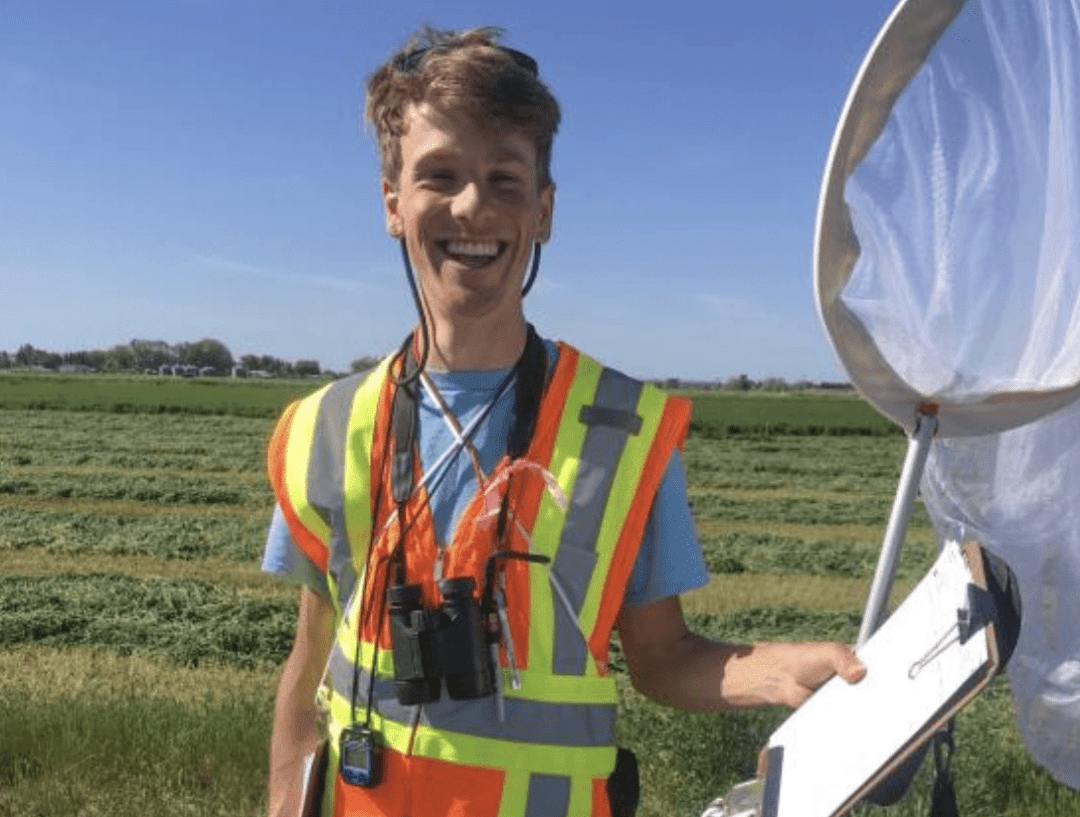Journal publishes Montana State scientists' paper on pollinators in roadside habitats
Friday Mar. 29th, 2024
 Montana State University ecology graduate Thomas Meinzen is pictured in Idaho conducting research on insects in roadside habitats. His review paper on the risks and benefits of such habitats to insect populaitons was published recently by the journal BioScience. Photo by Diane Debinski
Montana State University ecology graduate Thomas Meinzen is pictured in Idaho conducting research on insects in roadside habitats. His review paper on the risks and benefits of such habitats to insect populaitons was published recently by the journal BioScience. Photo by Diane Debinski
BOZEMAN – Spring is here, and soon the insects we notice all around us during Montana’s temperate seasons will reappear in yards, fields, outdoor recreation areas and along roadsides. With them will be the pollinators, such as bees and butterflies, that are frequently found living, nesting and foraging amid roadside flora.
But are such habitats helpful or harmful to the species that use them? The question has been the subject of study for years, and a review article by a Montana State University graduate detailing the research of hundreds of scientists was published recently in the journal BioScience.
“The BioScience paper was essentially an introduction to my thesis,” said lead author Thomas Meinzen, who in 2023 earned his master’s degree in biological sciences in MSU’s Department of Ecology in the College of Letters and Science. “I felt like this was the most important part because it’s really addressing questions about the overall impact of roadsides on (insect) population levels.”
Building on his lifelong enthusiasm for biology and natural history, Meinzen’s interest in these questions grew when he took an applied population ecology class during his MSU coursework.
“I learned that vital rates—birth, death and emigration—are so important in understanding how habitats can benefit or harm species,” he said.
Numerous studies highlight the floral resources and connectivity pathways provided by road verges, while others explore the attendant risks, including traffic collisions, pollutants, herbicides and mowing activities. Yet scientists don’t know how these benefits and risks balance out, and whether roadside habitats are more harmful or helpful to insect populations.
“A lot of these questions are unanswered – not because no one’s thinking about them, but because there’s so much we still don’t know about insects,” Meinzen said.
While at MSU, Meinzen set out to fill a portion of that knowledge gap by conducting a study on enhancing roadside habitat for pollinator conservation funded by the Idaho Transportation Department. The study became the bulk of his master’s thesis, for which he spent two summers conducting fieldwork at 63 different road verges in southeastern Idaho, including along state, U.S. and interstate highways.
Meinzen surveyed plants, bees and butterflies at each of the 63 sites twice each summer, as well as at a subset of the verges each August. He said the data provided a sense of how plant and flower communities relate to butterfly and bee diversity and how the highway type influenced diversity at each site.
“We found the overall result was that smaller, state highways had greater bee diversity. Bee diversity was also higher in less green areas, which was not what we anticipated,” he said. “We found, at least in southern Idaho, that the bright green areas tend to be dominated by non-native, invasive plants, while the drier, browner areas had native plants like sagebrush and tended to be better for bees.”
Results of the butterfly surveys were less conclusive, he said, probably because butterflies are more likely than bees to be generalists with wider habitats and less specific floral preferences. The survey results helped the MSU team formulate recommendations for Idaho’s roadside managers to prioritize plantings for pollinators along smaller highways and to protect sagebrush ecosystems.
“Sagebrush habitats might not look as showy, but they seemed to provide what bees needed – open ground for nesting and a variety of different blooms throughout the growing season, which is better than a lot of flowers one time of year,” Meinzen said.
Because his work in Idaho answered only some of the myriad questions ecologists have about roadside habitats, Meinzen said, he wrote the review of many additional studies to synthesize the wealth of information available for those creating roadside management plans.
The article was selected as the Editor’s Choice for the January edition of BioScience. And Meinzen – along with co-authors Diane Debinski, head of MSU’s ecology department, and MSU ecology professor Laura Burkle – were interviewed about roadside habitats and pollinators for the BioScience Talks podcast last month.
“It’s exciting as a young scientist to have a paper selected for that award and podcast, so I could share these ideas in a way that’s hopefully more accessible to people,” said Meinzen, who now works as an urban forester in Portland, Oregon.
His advice to anyone wishing to help native pollinators is to avoid using herbicides and pesticides when possible and to prioritize native flowers and ground cover when choosing plants.
“It’s important for people to know pollinators are declining really rapidly, and that it’s a big concern,” he said. “Trying to promote a diverse, native ecosystem without pesticides is the best way we can help native pollinators.”
| Tweet |